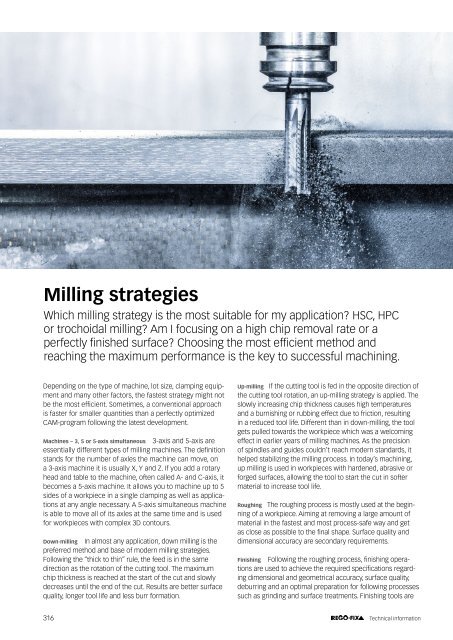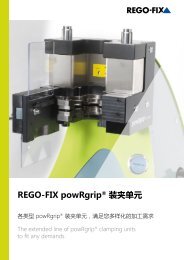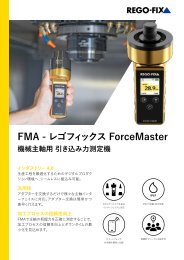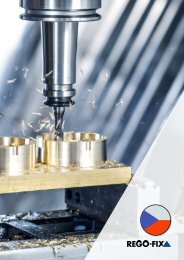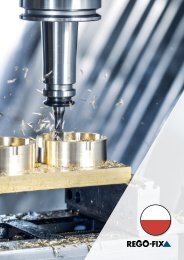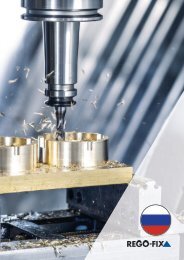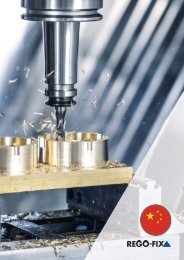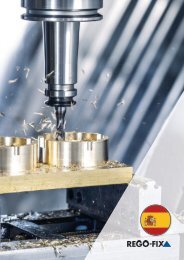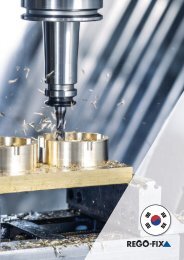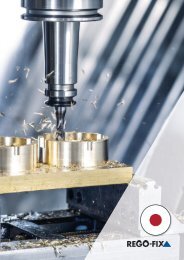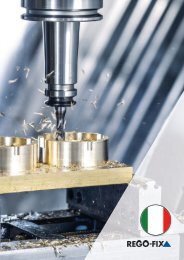REGO-FIX Main Catalogue ENGLISH
You also want an ePaper? Increase the reach of your titles
YUMPU automatically turns print PDFs into web optimized ePapers that Google loves.
Milling strategies<br />
Which milling strategy is the most suitable for my application? HSC, HPC<br />
or trochoidal milling? Am I focusing on a high chip removal rate or a<br />
perfectly finished surface? Choosing the most efficient method and<br />
reaching the maximum performance is the key to successful machining.<br />
Depending on the type of machine, lot size, clamping equipment<br />
and many other factors, the fastest strategy might not<br />
be the most efficient. Sometimes, a conventional approach<br />
is faster for smaller quantities than a perfectly optimized<br />
CAM-program following the latest development.<br />
Machines – 3, 5 or 5-axis simultaneous 3-axis and 5-axis are<br />
essentially different types of milling machines. The definition<br />
stands for the number of axles the machine can move, on<br />
a 3-axis machine it is usually X, Y and Z. If you add a rotary<br />
head and table to the machine, often called A- and C-axis, it<br />
becomes a 5-axis machine. It allows you to machine up to 5<br />
sides of a workpiece in a single clamping as well as applications<br />
at any angle necessary. A 5-axis simultaneous machine<br />
is able to move all of its axles at the same time and is used<br />
for workpieces with complex 3D contours.<br />
Down-milling In almost any application, down milling is the<br />
preferred method and base of modern milling strategies.<br />
Following the “thick to thin” rule, the feed is in the same<br />
direction as the rotation of the cutting tool. The maximum<br />
chip thickness is reached at the start of the cut and slowly<br />
decreases until the end of the cut. Results are better surface<br />
quality, longer tool life and less burr formation.<br />
Up-milling If the cutting tool is fed in the opposite direction of<br />
the cutting tool rotation, an up-milling strategy is applied. The<br />
slowly increasing chip thickness causes high temperatures<br />
and a burnishing or rubbing effect due to friction, resulting<br />
in a reduced tool life. Different than in down-milling, the tool<br />
gets pulled towards the workpiece which was a welcoming<br />
effect in earlier years of milling machines. As the precision<br />
of spindles and guides couldn’t reach modern standards, it<br />
helped stabilizing the milling process. In today’s machining,<br />
up milling is used in workpieces with hardened, abrasive or<br />
forged surfaces, allowing the tool to start the cut in softer<br />
material to increase tool life.<br />
Roughing The roughing process is mostly used at the beginning<br />
of a workpiece. Aiming at removing a large amount of<br />
material in the fastest and most process-safe way and get<br />
as close as possible to the final shape. Surface quality and<br />
dimensional accuracy are secondary requirements.<br />
Finishing Following the roughing process, finishing operations<br />
are used to achieve the required specifications regarding<br />
dimensional and geometrical accuracy, surface quality,<br />
deburring and an optimal preparation for following processes<br />
such as grinding and surface treatments. Finishing tools are<br />
316 Technical information


